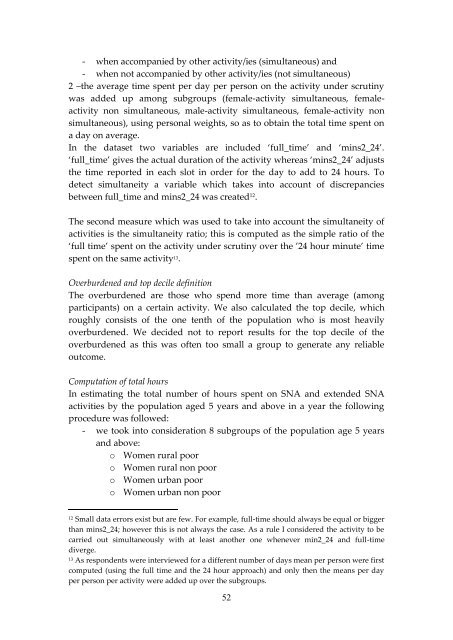Patterns of time use in Tanzania: how to make public investment in ...
Patterns of time use in Tanzania: how to make public investment in ...
Patterns of time use in Tanzania: how to make public investment in ...
You also want an ePaper? Increase the reach of your titles
YUMPU automatically turns print PDFs into web optimized ePapers that Google loves.
- when accompanied by other activity/ies (simultaneous) and<br />
- when not accompanied by other activity/ies (not simultaneous)<br />
2 –the average <strong>time</strong> spent per day per person on the activity under scrut<strong>in</strong>y<br />
was added up among subgroups (female-activity simultaneous, femaleactivity<br />
non simultaneous, male-activity simultaneous, female-activity non<br />
simultaneous), us<strong>in</strong>g personal weights, so as <strong>to</strong> obta<strong>in</strong> the <strong>to</strong>tal <strong>time</strong> spent on<br />
a day on average.<br />
In the dataset two variables are <strong>in</strong>cluded ‘full_<strong>time</strong>’ and ‘m<strong>in</strong>s2_24’.<br />
‘full_<strong>time</strong>’ gives the actual duration <strong>of</strong> the activity whereas ‘m<strong>in</strong>s2_24’ adjusts<br />
the <strong>time</strong> reported <strong>in</strong> each slot <strong>in</strong> order for the day <strong>to</strong> add <strong>to</strong> 24 hours. To<br />
detect simultaneity a variable which takes <strong>in</strong><strong>to</strong> account <strong>of</strong> discrepancies<br />
between full_<strong>time</strong> and m<strong>in</strong>s2_24 was created 12 .<br />
The second measure which was <strong>use</strong>d <strong>to</strong> take <strong>in</strong><strong>to</strong> account the simultaneity <strong>of</strong><br />
activities is the simultaneity ratio; this is computed as the simple ratio <strong>of</strong> the<br />
‘full <strong>time</strong>’ spent on the activity under scrut<strong>in</strong>y over the ’24 hour m<strong>in</strong>ute’ <strong>time</strong><br />
spent on the same activity 13.<br />
Overburdened and <strong>to</strong>p decile def<strong>in</strong>ition<br />
The overburdened are those who spend more <strong>time</strong> than average (among<br />
participants) on a certa<strong>in</strong> activity. We also calculated the <strong>to</strong>p decile, which<br />
roughly consists <strong>of</strong> the one tenth <strong>of</strong> the population who is most heavily<br />
overburdened. We decided not <strong>to</strong> report results for the <strong>to</strong>p decile <strong>of</strong> the<br />
overburdened as this was <strong>of</strong>ten <strong>to</strong>o small a group <strong>to</strong> generate any reliable<br />
outcome.<br />
Computation <strong>of</strong> <strong>to</strong>tal hours<br />
In estimat<strong>in</strong>g the <strong>to</strong>tal number <strong>of</strong> hours spent on SNA and extended SNA<br />
activities by the population aged 5 years and above <strong>in</strong> a year the follow<strong>in</strong>g<br />
procedure was followed:<br />
- we <strong>to</strong>ok <strong>in</strong><strong>to</strong> consideration 8 subgroups <strong>of</strong> the population age 5 years<br />
and above:<br />
o Women rural poor<br />
o Women rural non poor<br />
o Women urban poor<br />
o Women urban non poor<br />
12 Small data errors exist but are few. For example, full-<strong>time</strong> should always be equal or bigger<br />
than m<strong>in</strong>s2_24; <strong>how</strong>ever this is not always the case. As a rule I considered the activity <strong>to</strong> be<br />
carried out simultaneously with at least another one whenever m<strong>in</strong>2_24 and full-<strong>time</strong><br />
diverge.<br />
13 As respondents were <strong>in</strong>terviewed for a different number <strong>of</strong> days mean per person were first<br />
computed (us<strong>in</strong>g the full <strong>time</strong> and the 24 hour approach) and only then the means per day<br />
per person per activity were added up over the subgroups.<br />
52

















